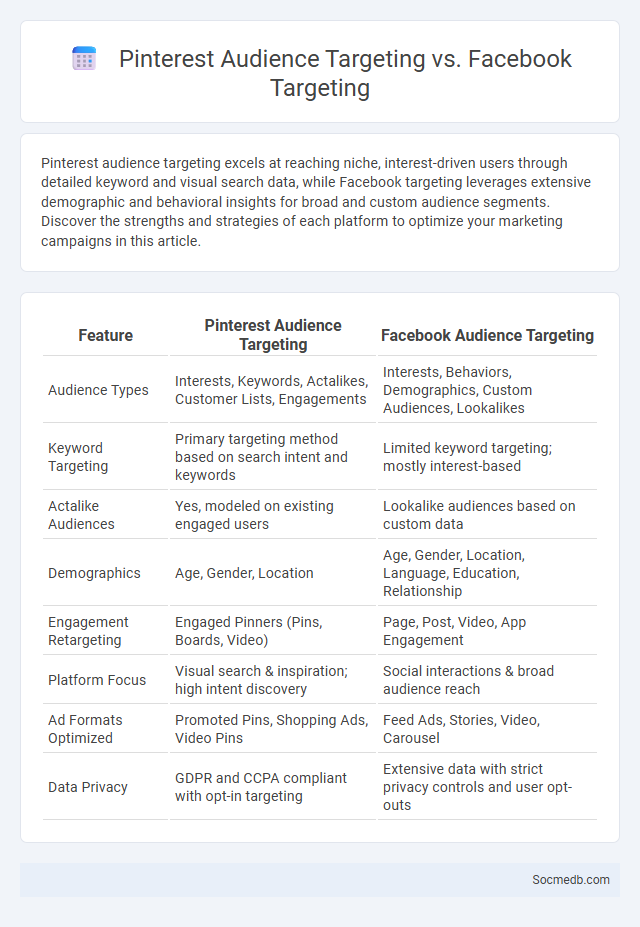
Photo illustration: Pinterest Audience Targeting vs Facebook Targeting
Pinterest audience targeting excels at reaching niche, interest-driven users through detailed keyword and visual search data, while Facebook targeting leverages extensive demographic and behavioral insights for broad and custom audience segments. Discover the strengths and strategies of each platform to optimize your marketing campaigns in this article.
Table of Comparison
| Feature | Pinterest Audience Targeting | Facebook Audience Targeting |
|---|---|---|
| Audience Types | Interests, Keywords, Actalikes, Customer Lists, Engagements | Interests, Behaviors, Demographics, Custom Audiences, Lookalikes |
| Keyword Targeting | Primary targeting method based on search intent and keywords | Limited keyword targeting; mostly interest-based |
| Actalike Audiences | Yes, modeled on existing engaged users | Lookalike audiences based on custom data |
| Demographics | Age, Gender, Location | Age, Gender, Location, Language, Education, Relationship |
| Engagement Retargeting | Engaged Pinners (Pins, Boards, Video) | Page, Post, Video, App Engagement |
| Platform Focus | Visual search & inspiration; high intent discovery | Social interactions & broad audience reach |
| Ad Formats Optimized | Promoted Pins, Shopping Ads, Video Pins | Feed Ads, Stories, Video, Carousel |
| Data Privacy | GDPR and CCPA compliant with opt-in targeting | Extensive data with strict privacy controls and user opt-outs |
Introduction: Understanding Social Media Audience Targeting
Social media audience targeting involves identifying and reaching specific groups based on demographics, interests, and online behaviors to maximize engagement and conversion rates. Platforms like Facebook, Instagram, and LinkedIn offer advanced tools to segment audiences, allowing you to tailor content and advertisements that resonate with your ideal customers. Your ability to leverage data analytics and user insights is crucial for optimizing campaigns and driving meaningful interactions.
Overview of Pinterest Audience Targeting Features
Pinterest audience targeting enables advertisers to precisely reach users based on demographics, interests, and behaviors, enhancing campaign relevance and effectiveness. Key features include custom audiences, enabling retargeting with uploaded customer lists, and actalike audiences that extend reach to users similar to existing customers. Interest targeting allows brands to connect with users actively engaging in specific categories like fashion, home decor, or DIY projects.
Facebook Targeting Capabilities Explained
Facebook targeting capabilities enable advertisers to reach specific audiences based on detailed demographics, interests, behaviors, and location data. Custom Audiences allow marketers to retarget existing customers by uploading contact lists or engaging users who interacted with their content. Lookalike Audiences expand reach by finding users similar to a brand's most valuable customers, enhancing ad relevance and campaign effectiveness.
What is Paid Promotion Across Social Platforms?
Paid promotion across social platforms involves using targeted advertisements to reach specific audiences on networks like Facebook, Instagram, Twitter, and LinkedIn. These ads are designed to increase visibility, drive traffic, and boost engagement by leveraging user data and platform algorithms for precise targeting. Understanding how paid promotion works can help you maximize your social media marketing ROI and achieve your business goals efficiently.
Comparing Audience Demographics: Pinterest vs Facebook
Pinterest attracts a predominantly female audience, with 60% of users aged 25-54, making it ideal for brands targeting women interested in lifestyle, fashion, and DIY content. Facebook offers a more balanced gender distribution and a broader age range, with over 70% of users aged 18-49, appealing to diverse interests from social networking to news and entertainment. Marketers should consider Pinterest's niche, visually-driven community for targeted campaigns, while leveraging Facebook's vast, versatile user base for wide-reaching brand engagement.
Targeting Precision: Interests, Behaviors, and Custom Audiences
Social media platforms offer unparalleled targeting precision by leveraging user interests, behaviors, and custom audiences to deliver highly relevant ads. Advertisers can create campaigns based on detailed data such as browsing history, purchase behavior, and demographic profiles, optimizing reach to users most likely to engage. Utilizing custom audiences from email lists or website traffic further enhances campaign effectiveness by re-engaging existing customers with personalized content.
Ad Creative and Format Options: Pinterest vs Facebook
Pinterest offers visually-driven ad creatives like Promoted Pins and Idea Pins that blend seamlessly into user feeds, making them ideal for brand storytelling and product discovery. Facebook provides diverse ad formats including carousel, video, and collection ads, allowing you to tailor campaigns for engagement, conversions, and direct sales efficiently. Choosing between the two depends on your target audience, with Pinterest excelling in inspiration-focused content and Facebook delivering robust targeting and interactive options.
Budgeting and ROI: Cost-Effectiveness Analysis
Social media budgeting requires precise allocation of funds based on platform performance metrics and audience engagement rates to maximize ROI. Analyzing cost-effectiveness involves tracking conversion rates, customer acquisition cost (CAC), and lifetime value (LTV) to ensure marketing spend yields profitable returns. Leveraging analytics tools to monitor campaign KPIs enables businesses to optimize budget distribution and improve overall social media ROI.
Performance Metrics and Analytics Comparison
Performance metrics for social media platforms include engagement rate, reach, click-through rate (CTR), and conversion rate, which provide insights into audience interaction and campaign effectiveness. Analytics tools like Facebook Insights, Twitter Analytics, and Instagram Insights offer comparative data on follower growth, post performance, and demographic breakdowns to optimize content strategies. By analyzing these metrics, marketers can refine targeting, increase ROI, and enhance overall social media presence.
Choosing the Right Platform for Your Brand Goals
Choosing the right social media platform for your brand goals requires understanding your target audience's preferences and behaviors on each channel. Platforms like Instagram and TikTok excel in visual storytelling, ideal for brands focusing on lifestyle and engagement, while LinkedIn is suited for B2B connections and professional networking. Aligning your content strategy with the platform's strengths ensures maximum reach and meaningful interactions for your brand's growth.
 socmedb.com
socmedb.com